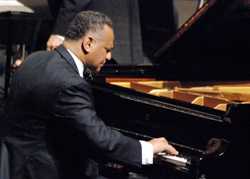by Tom Wachunas

His Suite for Strings is a brilliant platform for showcasing the depth and sensitivity of this orchestra’s string section. From the lush and pastoral sweep of the first movement, the delightful precision of the Tchaikovsky-esque Pizzicato second movement, and throughout the churning power of the finale, the orchestra was altogether breathtaking. An added delight here was the Masterworks debut appearance of CSO Assistant Conductor Rachel Waddell at the podium. The gentle yet impassioned physicality of her conducting style elicited an equally vivacious orchestral response to the lyrical thrust of the work.
Speaking of lyrical thrust, at one point in the heroic finale of the next program selection – Howard Hanson’s Symphony No. 2 (“Romantic”) – Maestro Gerhardt Zimmermann’s baton became airborne, landing at the feet of nine year-old Mya Miller who was seated in the front row. She couldn’t get Zimmermann’s attention as he walked offstage at intermission, so she dutifully handed the baton to one of the violinists. Not even a minute later Zimmermann, smiling broadly, walked back out to the edge of the stage and handed the baton back to starstruck Mya. Talk about a rewarding experience…
And for those who traveled through unprecedented polar weather conditions to attend the concert, bravery was rewarded with the incomparable event of witnessing Edward MacDowell’s Concerto No.2 in D Minor performed by guest pianist André Watts. I could read his animated face. He has a unique, enchanting way of apparently “speaking” cascades of fleet-fingered notes with uncanny authority. As if he were a wizard, he conjured tones and moods that were alternately delicate and tumultuous, soft and sinewy, ebullient and brooding. His adventuresome sonority and sublime technique throughout the work were seamlessly entwined with the emotive clarity of the orchestra. It’s difficult to imagine that Watts has ever played better, or this orchestra ever more attentive to a soloist. This was an astonishing performance that brought the audience immediately to its feet in a collective paroxysm of praise.
Next, the program took a curious turn. Watts’ compelling performance was a true show-stopper. A follow-up piece of any sort would seem counterintuitive at best. So I remain conflicted about the program placement of the evening’s final selection – The Incredible Flutist Suite by Walter Piston.
Not that the work as performed by the orchestra here wasn’t wildly invigorating and charming in its own right. In fact it’s downright rambunctious in parts, including the section called Arrival of the Circus and Circus March, wherein orchestra members hilariously vocalize the sounds of a boisterous circus crowd, complete with Zimmermann’s climactic dog bark (followed by an orchestra member’s cat howl). Still, the high-energy theatricality of Piston’s suite was for me an unnecessary intrusion on savoring the magnificent accomplishment of André Watts.
Published on ClevelandClassical.com January 28, 2014
Click here for a printable version of this article.



